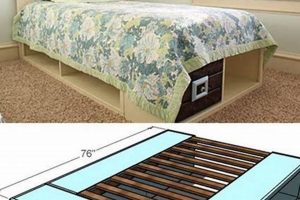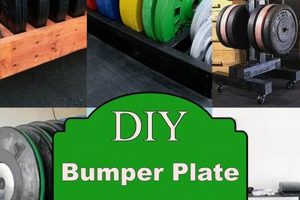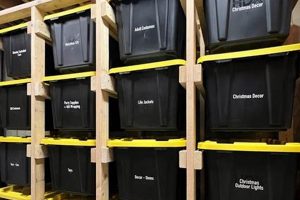Creating airtight enclosures for textiles and compressible materials utilizing readily available household items is a practical solution for space optimization. For instance, repurposing common plastic bags in conjunction with a standard vacuum cleaner allows individuals to significantly reduce the volume occupied by items such as clothing, bedding, and seasonal decorations.
This method of containment offers multiple advantages, including protection from dust, moisture, and pests, thereby preserving the integrity of stored goods. The historical precedent for this practice lies in the ongoing human effort to efficiently manage and preserve resources, adapting available technologies to achieve practical storage solutions.
The subsequent discussion will delve into specific techniques for constructing effective versions of these space-saving storage solutions, exploring materials, sealing methods, and optimal vacuuming procedures to ensure long-term preservation and volume reduction.
Construction and Utilization Guidance
The following guidelines detail best practices for the fabrication and use of homemade compressed storage solutions. Adherence to these principles will enhance effectiveness and longevity.
Tip 1: Material Selection. Employ heavy-gauge polyethylene or polypropylene bags. Thicker plastics resist tearing and maintain a more secure seal under vacuum pressure. Examine the integrity of the material before use.
Tip 2: Closure Integrity. Secure the bag opening with a robust zip-closure mechanism or airtight tape. Double-sealing the opening reduces the likelihood of air leakage over time.
Tip 3: Valve Adaptation. Integrate a one-way valve constructed from plastic tubing and a small piece of flexible material, such as rubber or a portion of a balloon. This facilitates air removal and prevents backflow.
Tip 4: Vacuum Application. Utilize a vacuum cleaner hose with a nozzle attachment to extract air. Ensure a tight seal between the hose and the bag’s valve or opening to maximize air removal efficiency.
Tip 5: Gradual Compression. Apply vacuum pressure incrementally. Over-compression can damage sensitive items or compromise the bag’s structural integrity. Observe the contents during the vacuuming process.
Tip 6: Storage Environment. Store compressed bags in a dry, temperature-controlled environment away from direct sunlight. Extreme temperature fluctuations can affect the bag’s seal and the contents within.
Tip 7: Periodic Inspection. Routinely inspect the bags for signs of leakage or damage. Re-vacuum and reseal as needed to maintain optimal compression and protection.
By following these directives, individuals can effectively create and utilize cost-efficient compressed storage alternatives, reducing storage volume and safeguarding items from environmental factors.
The subsequent section will explore alternative strategies and advanced techniques for enhancing the effectiveness of these storage solutions.
1. Material Selection
The effectiveness of creating airtight storage solutions is intrinsically linked to the choice of materials. Material properties directly influence the bag’s ability to maintain a vacuum seal, withstand physical stress, and protect contents from environmental factors.
- Polymer Type and Thickness
The selection of polymer, typically polyethylene (PE) or polypropylene (PP), dictates durability and barrier properties. Thicker gauges (measured in mils or micrometers) provide increased resistance to puncture and tearing, crucial for long-term storage. Variations in polymer density also affect flexibility and resistance to temperature changes.
- Seam Strength and Integrity
Seam strength, determined by the bonding method (heat sealing, adhesive bonding), is critical for maintaining the airtight seal under vacuum pressure. Weak seams are prone to failure, resulting in air leakage and compromising the bag’s effectiveness. Evaluating the seal’s resistance to peel and shear forces is essential.
- Permeability to Gases
The inherent permeability of the selected material dictates its ability to prevent gas diffusion. High permeability allows atmospheric gases to penetrate the bag over time, leading to gradual reinflation. Materials with low gas permeability, such as multi-layer laminates incorporating barrier films (e.g., aluminum foil), offer superior long-term storage.
- Resistance to Degradation
Exposure to ultraviolet (UV) radiation, temperature extremes, and chemical agents can degrade the plastic, causing embrittlement, discoloration, and reduced mechanical strength. UV inhibitors and stabilizers can be incorporated into the polymer formulation to mitigate these effects, extending the bag’s lifespan.
These considerations highlight the pivotal role of informed material selection in the successful implementation of do-it-yourself compressed storage solutions. A thorough understanding of material properties ensures the creation of durable and effective storage containers.
2. Airtight Sealing
Airtight sealing represents a critical determinant of efficacy in do-it-yourself compressed storage. Its primary function is to maintain a reduced atmospheric pressure environment within the enclosure, thereby minimizing the volume occupied by stored items and protecting them from environmental contaminants.
- Closure Mechanism Integrity
The closure mechanism, whether a zipper, adhesive tape, or heat-sealed seam, must provide an impermeable barrier against atmospheric gases. Compromised closures result in gradual reinflation, negating the benefits of vacuum compression. Examples include double-track zippers with locking sliders, high-tack pressure-sensitive tapes, and precisely controlled heat sealing processes which all affect the final result of vacuumed sealed storage.
- Material Compatibility
The sealing material must exhibit chemical compatibility with the storage bag material to ensure durable adhesion. Incompatible materials may lead to delamination or degradation of the seal over time. Polyethylene bags may require specific adhesives formulated for polyethylene bonding. The compatibility of different materials affects long term results of the vacuum storage bag.
- Environmental Resistance
The airtight seal must withstand environmental stressors such as temperature fluctuations and humidity variations without compromising its integrity. Extreme temperatures can cause expansion or contraction of the sealing material, leading to gaps or failures. Moisture can weaken adhesive bonds or promote the growth of mold and mildew within the sealed environment. The stability of the environment that the diy vacuum storage bags are placed in greatly affects its usefulness.
- Sealing Surface Preparation
Proper surface preparation before sealing is essential for achieving a robust and reliable bond. Contaminants such as dust, grease, or moisture can impede adhesion and compromise the seal’s effectiveness. Cleaning the sealing surfaces with an appropriate solvent prior to closure can improve bond strength and longevity. Surface preparation is crucial for maximum success.
The aforementioned facets collectively underscore the significance of meticulous attention to airtight sealing techniques in the context of do-it-yourself compressed storage. A compromised seal renders the entire system ineffective, necessitating a comprehensive approach to material selection, closure mechanism design, and environmental control.
3. Valve Mechanism
The valve mechanism within a DIY vacuum storage bag system serves as the critical interface for air evacuation and subsequent retention of reduced pressure. Its functionality directly determines the degree of compression achievable and the longevity of the compressed state. Absent a properly functioning valve, air will infiltrate the bag, negating the intended volume reduction. A simple example involves a one-way valve constructed from a drinking straw and a small piece of balloon rubber. The straw inserted into a hole in the bag allows air to be sucked out, and the rubber flap prevents backflow. Its failure results in immediate reinflation.
Effective valve design must address several factors. First, the valve must create a tight seal against the bag material to prevent leakage around its perimeter. Second, the internal mechanism must allow for unimpeded airflow during vacuum application yet instantaneously seal upon removal of the vacuum source. Third, the valve material must be durable and resistant to degradation from repeated use and environmental exposure. Consider valves repurposed from commercial vacuum bags; their pre-engineered design offers reliability superior to makeshift alternatives. Furthermore, proper integration of the valve involves careful sealing with appropriate adhesives or heat welding techniques.
In summary, the valve mechanism is not merely an ancillary component but an integral element dictating the overall effectiveness of DIY vacuum storage bags. Its selection, construction, and installation demand careful consideration to ensure optimal performance. Challenges include sourcing reliable materials and achieving airtight seals, but the rewards of effective compression and long-term storage make the effort worthwhile. The success of these DIY projects hinges on this seemingly small, but vital, element.
4. Compression Technique
The efficacy of constructing compressed storage solutions hinges directly on the employed compression technique. Improper application of vacuum pressure can result in compromised storage volume reduction and potential damage to the stored items. The relationship is causal: ineffective techniques yield incomplete compression, while optimized techniques maximize space efficiency. For example, attempting to compress items with sharp edges without proper padding can lead to bag puncture, negating any compression effort. Thus, the practical significance of understanding proper compression methods is paramount to successful utilization.
A systematic approach to air extraction involves controlling the rate of vacuum application and the distribution of contents within the bag. Items should be arranged to evenly distribute pressure and avoid concentrated stress points. The vacuum source should be applied incrementally, allowing the bag material to conform gradually to the shape of the contents. This methodical approach minimizes the risk of material fatigue and seam stress. A real-world demonstration of this principle lies in the comparison between haphazardly stuffed bags, which often fail to compress effectively, and carefully packed bags, which achieve significant volume reduction.
In summary, the compression technique is an indispensable element of successfully creating compressed storage. Mastery of gradual vacuum application, coupled with thoughtful arrangement of contents, dictates the ultimate storage volume achieved and the preservation of stored items. The challenge lies in adapting the technique to the specific characteristics of the items being compressed, but a refined understanding offers substantial benefits in space optimization and material preservation.
5. Storage Environment
The ambient conditions in which compressed storage bags are placed exert a profound influence on their long-term performance and the preservation of their contents. The storage environment functions as a critical external factor, directly impacting the integrity of the bag material, the efficacy of the airtight seal, and the susceptibility of stored items to degradation. An adverse environment, such as one characterized by high humidity or temperature fluctuations, can compromise the seal’s integrity, leading to reinflation and nullifying the benefits of vacuum compression. For example, storing compressed textiles in a damp basement can foster mold growth, irrespective of the initial vacuum sealing, illustrating the primacy of environmental control. Therefore, understanding the interplay between environmental factors and storage bag performance constitutes a cornerstone of successful long-term preservation.
Practical application of this knowledge involves careful selection of storage locations. Ideal environments exhibit stable temperature and humidity levels, shielded from direct sunlight and extreme temperature fluctuations. Attics, prone to significant temperature swings, and garages, often subject to humidity and pest intrusion, represent suboptimal choices. Climate-controlled storage spaces, such as interior closets or dedicated storage units, provide a more suitable environment for maintaining the compressed state and safeguarding against material degradation. Moreover, employing desiccants or humidity-absorbing materials within the storage area can further mitigate the risks associated with moisture infiltration. These measures, while seemingly minor, contribute substantially to extending the lifespan and preserving the contents of compressed storage bags.
In summary, the storage environment is an indispensable consideration in the application of compressed storage. Its influence on material integrity, seal efficacy, and content preservation cannot be overstated. The challenge lies in proactively selecting appropriate storage locations and implementing environmental control measures to mitigate potential risks. A strategic approach, informed by an understanding of environmental factors, ensures the sustained effectiveness of compressed storage solutions and protects stored items from degradation, thereby maximizing the return on investment in storage techniques.
6. Periodic Inspection
Sustained effectiveness of compressed storage depends critically on consistent monitoring of the bag’s integrity. Regular inspection allows for early detection of compromised seals or material degradation, preventing complete loss of compression and potential damage to stored contents.
- Seal Integrity Assessment
Visual examination of the bag’s closure mechanism, whether a zipper, adhesive seal, or heat-welded seam, reveals potential breaches. A tactile assessment can identify subtle air leaks undetectable by sight alone. Early detection of seal compromise allows for timely resealing, preserving the compressed state.
- Material Degradation Analysis
Exposure to environmental factors, such as ultraviolet radiation or temperature fluctuations, can weaken the bag material over time. Periodic inspection involves examining the plastic for signs of embrittlement, discoloration, or cracking. Detection of material degradation necessitates bag replacement to maintain storage integrity.
- Vacuum Retention Monitoring
The primary indicator of effective compression is the maintenance of a reduced atmospheric pressure within the bag. Monitoring the bag’s volume and firmness provides a direct assessment of vacuum retention. Gradual reinflation signals a leak or seal failure requiring immediate attention.
- Pest and Moisture Intrusion Evaluation
Compromised bags are susceptible to pest infestation and moisture accumulation, jeopardizing the stored contents. Inspection involves checking for signs of insect activity or water damage within the bag. Early detection of intrusion allows for appropriate remedial action to prevent further damage.
These facets underscore the importance of integrating periodic inspection into the utilization of compressed storage solutions. Consistent monitoring of seal integrity, material condition, vacuum retention, and potential intrusion risks ensures the long-term effectiveness of diy vacuum storage bags and safeguards the stored items from environmental degradation.
Frequently Asked Questions
The following addresses common inquiries regarding the creation and effective utilization of homemade compressed storage solutions.
Question 1: What types of bags are suitable for creating compressed storage?
Heavy-gauge polyethylene or polypropylene bags are recommended. Thinner materials are prone to tearing under vacuum pressure, compromising the airtight seal.
Question 2: How can an airtight seal be ensured without specialized equipment?
Double sealing with high-quality packing tape or employing a robust zip-closure mechanism is advisable. Examine the seal for any imperfections prior to air extraction.
Question 3: Is a vacuum cleaner essential for air removal?
A vacuum cleaner provides the most efficient air removal. However, manual compression followed by sealing can offer a limited degree of volume reduction.
Question 4: How should contents be prepared before compression?
Clean and dry all items prior to storage. Sharp objects should be padded or removed to prevent bag punctures.
Question 5: What environmental factors can negatively impact compressed storage?
Exposure to direct sunlight, extreme temperature fluctuations, and high humidity levels can degrade bag material and compromise the airtight seal.
Question 6: How often should compressed storage bags be inspected?
Inspect bags at least every three months for signs of leakage, material degradation, or pest intrusion. Prompt action mitigates potential damage.
Consistent application of these guidelines promotes the successful utilization of cost-effective compressed storage solutions.
The following section will explore advanced methods to enhance the benefits of “diy vacuum storage bags”.
diy vacuum storage bags
This exploration has illuminated the multifaceted considerations inherent in employing do-it-yourself compressed storage solutions. From selecting appropriate materials and ensuring airtight seals to implementing effective valve mechanisms and controlling the storage environment, each element contributes significantly to the system’s overall performance.
The pursuit of optimized storage remains a pragmatic endeavor. Recognizing the inherent limitations and diligently applying best practices offers the most effective pathway to maximizing space efficiency and preserving stored items. The future of these methods lies in continued refinement and adaptation to individual needs.







